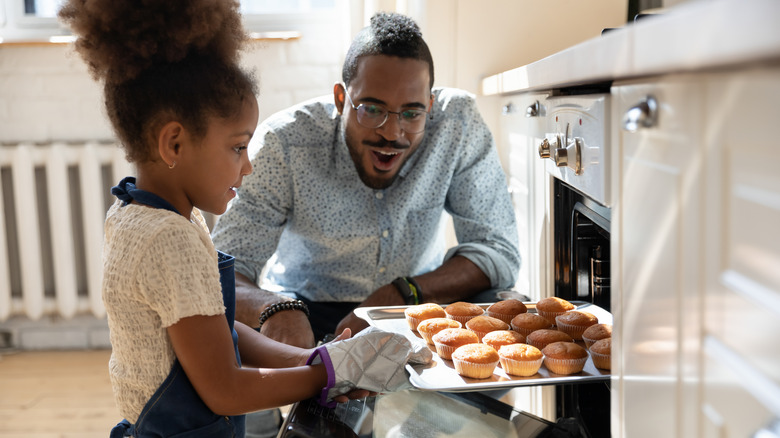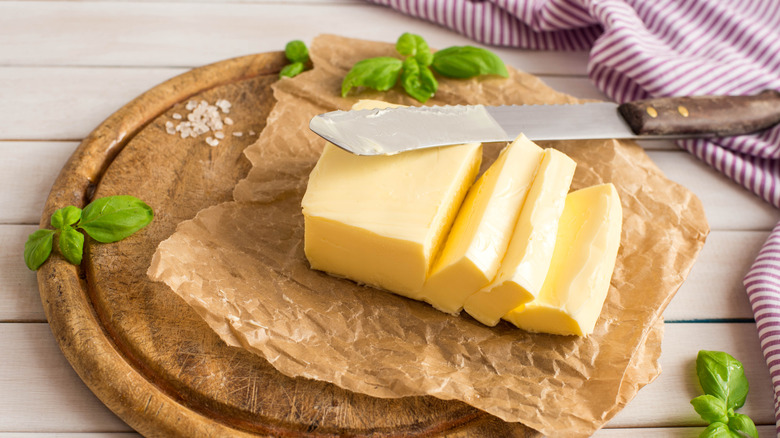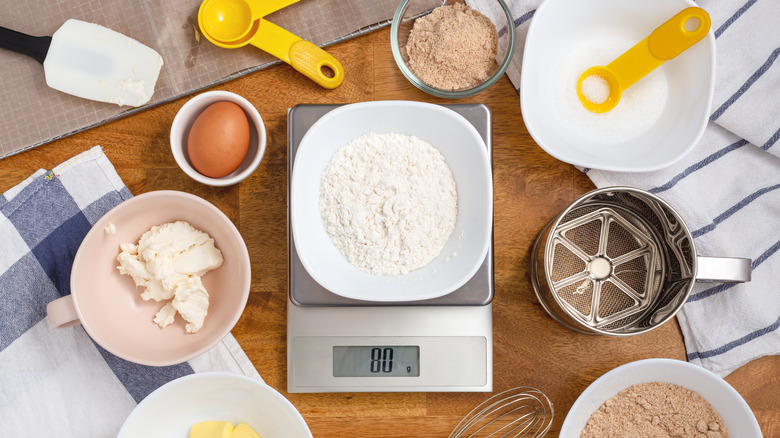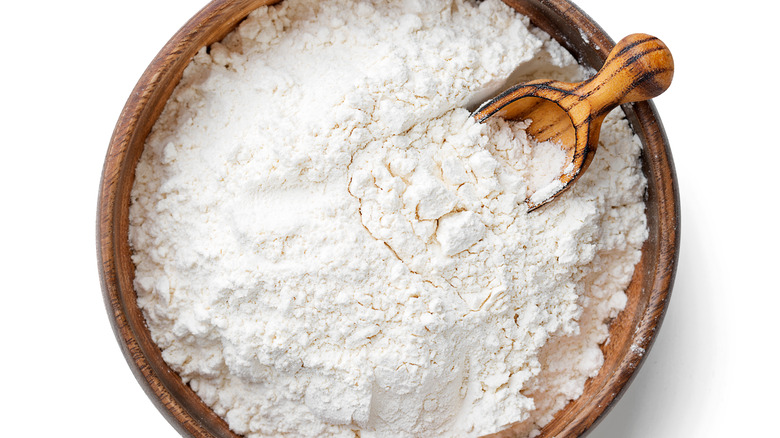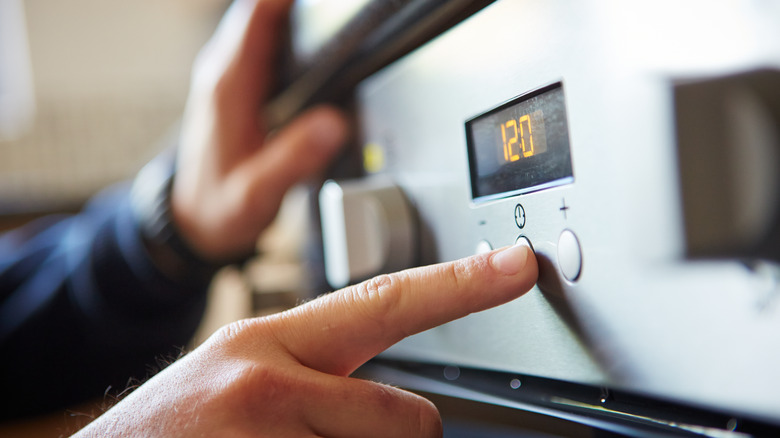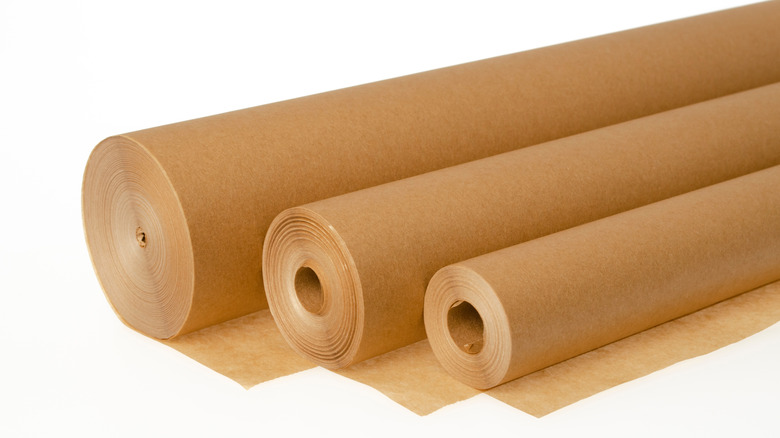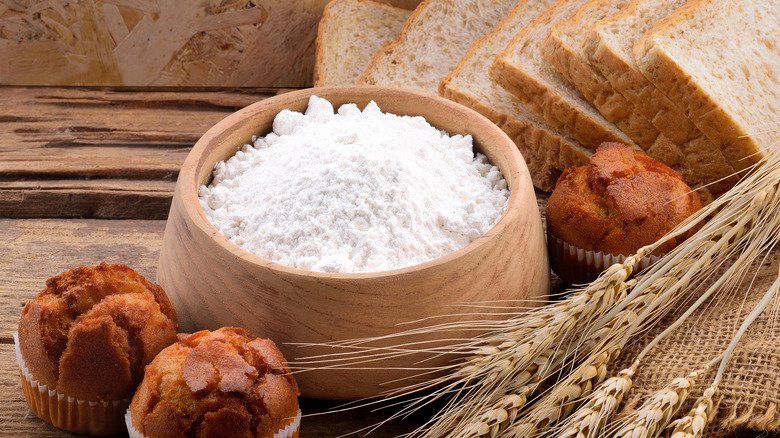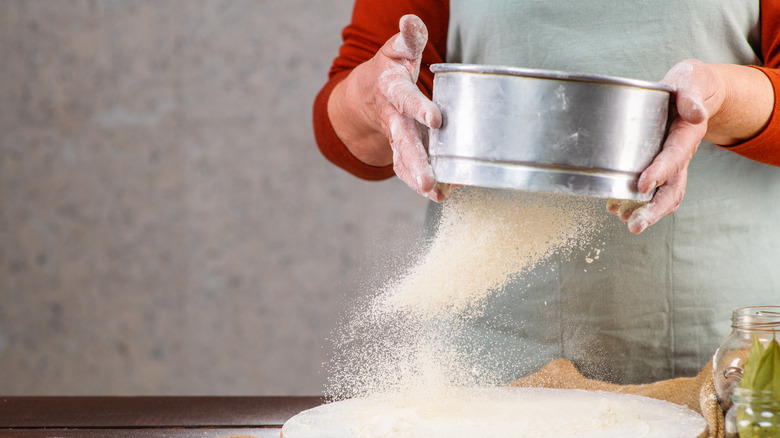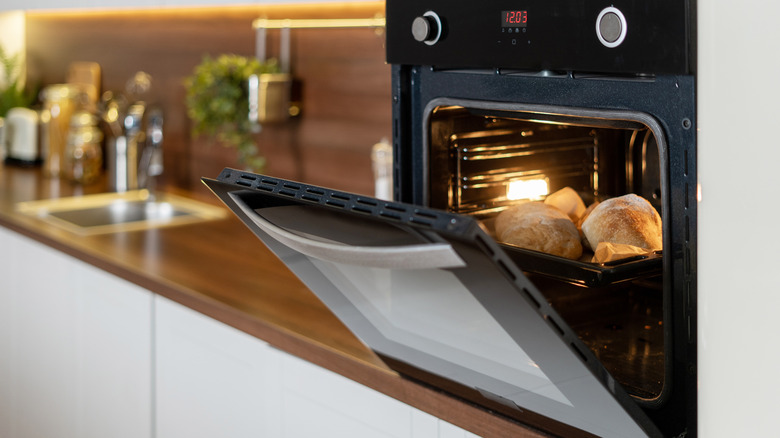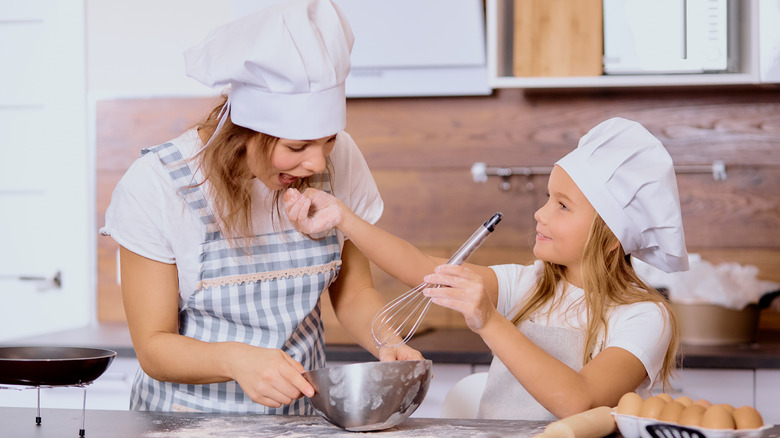The Biggest Mistakes You're Making While Baking
Whether you've been baking for years or you just got your first taste of bread-making during quarantine, it can be easy to make mistakes. Baking is a science as well as an art, which means you really have to know what you're doing to avoid any mishaps in the kitchen. If you're having problems when you bake, you may be wondering what the problem is. If you've gone back and scoured the recipe only to come up with a big question mark regarding what you did wrong, you're not alone.
That's why we've compiled a list of some of the most common mistakes people make when they're baking. Some of them may seem obvious, others less so. But hopefully, it will lend you some insight into how you could be making your baked goods even better. By avoiding these few mistakes, you'll have a much greater chance of success in all of your baking endeavors. Ready to learn more? These are the biggest mistakes you're making while baking.
Using ingredients at the wrong temperature
Most of the time, when you're cooking something instead of baking it, you don't have to pay super-close attention to the temperature of the ingredients. Sure, you want to make sure your chicken is thawed before you start cooking it, but no ingredient is ever going to specify that you need to use a room-temperature bell pepper. However, when it comes to baking, the temperature of the ingredients you use actually may be important, and if you can't figure out what's going wrong with your baked goods, this issue might be the culprit.
Not only are you going to want to ensure that your ingredients are at the right temperature, but you should resist the urge to heat butter or other ingredients up in the microwave to bring them to temperature faster. It's too easy to overheat your ingredients, which can lead to a big mess once you try to throw all of the other ingredients together. Rather, make sure you give yourself plenty of time to place the necessary ingredients out on the counter before you begin baking.
Not reading the entire recipe before you start baking
Here's another common mistake that can make or break your bake: not reading the entire recipe before you get started. This may not seem like a big deal ... until you realize that the recipe is going to take you two hours longer than you had originally planned or you need a small amount of an ingredient that you don't happen to have stocked in your pantry. That's why it's so important to read the entire recipe beforehand. Not only will you figure out what you need to buy at the grocery store, but you'll also have a better idea of all the steps you'll have to take to finish your baking project.
We recommend making your way through the recipe at least three times. The first time you read through it, you'll gather information about what you need to get from the store and take note of how much time it'll take you to throw the recipe together. The second time you read it should be right before you start baking. This will ensure that you didn't miss any important ingredients or steps before you begin. Finally, you'll read the recipe once more while you're actually in the process of making it.
Reading through the recipe beforehand doesn't take too long, and it's a great way to ensure that your baking experience will be as stress-free as possible.
Not letting your baked goods rest before decorating or serving
We get it. After you spend so long on a baking project, the second it comes out of the oven, you'll want to move onto the next step, whether that's slicing into your loaf of bread or putting the icing on the cake you worked so hard on. And while that urge is understandable, it doesn't mean you should give into it. Why? Because when you don't let your baked goods rest and cool after they come out of the oven, you could run into some problems.
For example, cookies can be super-delicate when they first come out of the oven, which means you don't want to try to move them off their sheet right away if you want them to stay intact. Additionally, trying to put frosting on a cake or cupcakes when they're too warm will result in melted, unappetizing frosting that nobody will want. And you can completely ruin the texture of bread simply by slicing into the loaf too soon.
While you don't have to let your baked goods cool completely, give them a few minutes to release some of that heat before you dig in. After all, we're sure that anything you're making is worth the wait.
Forgetting to use a scale
If you live in the U.S. and most of the recipes you follow use the imperial system, you may not see the need to use a scale when you're baking. But really, if you want to get the right measurements every time, using a scale is of the utmost importance — especially when you're working with really finicky recipes. That's because you can over- or under-fill a measuring cup, which can result in a seriously messed-up baking project. Sure, it's not always the end of the world, but you'll have a lot more consistency in your baking if you do opt to use a scale. And a scale is the most accurate way to ensure you're getting the perfect amount of every ingredient into your mixing bowl.
Concerned that you're going to have to drop a ton of money just to get the right kind of scale? Don't worry — that shouldn't be a problem. You can find kitchen scales for under $15, so you won't have to break the bank just to get your measurements right.
Confusing baking powder and baking soda
One mistake almost everyone makes at least once is mixing up baking soda and baking powder. We get it — they sound similar and are both white powders. But if you thought that you could easily replace one for the other in your recipes, think again. They're completely different ingredients that serve different purposes in your baked goods. Baking soda requires the presence of an acid to work as a leavener, or an ingredient that gives your baked goods the fluffy texture you're looking for. Generally, a recipe that calls for just baking soda will already include an acid. On the other hand, baking powder contains both baking soda and another ingredient called cream of tartar. Basically, it already has its own acid.
Sound confusing? You don't have to worry about the details. Just know that if a recipe calls for either baking soda or baking powder, you can't replace one with the other. Keep both stocked in your pantry for easy access whenever you start a baking project.
Forgetting to preheat your oven
When you're getting ready to bake, there's a lot to think about. First of all, you need to make sure you have all your ingredients in front of you and ready to go. Secondly, you need to get out all of your baking tools like a mixing bowl, a rolling pin, or whatever else you need for your particular recipe. And then there's reading through the recipe to ensure everything's in order before you get started. Therefore, it's understandable that you would forget to preheat your oven from time to time. And while you think that you can just pop your baked goods into the oven and turn it on afterward, we're here to tell you that, unfortunately, it's not that simple.
Forgetting to preheat your oven is a major mistake that can cause your baked goods to come out undercooked. For some recipes, even a minute or two can make a big difference, so if your oven isn't already up to heat by the time you add the baked goods inside, they're not going to cook as quickly as they should. Since the oven will be preheating slowly, it's hard to even predict when they'll be done. Therefore, make sure you preheat your oven before you get started on anything else with the recipe.
Not using parchment paper
If you bake enough, you know that it can be a total mess, especially when ingredients stick to the bottom or sides of your baking dish. This can add a ton of cleanup time to your baking endeavors, and the thought alone of the mess may keep you from attempting more ambitious baking projects. But what if there were an easy way to avoid the mess stuck to the bottom of the pan? There is one, and it's a simple one at that: parchment paper. There's a good chance you already have some at home. If not, it's easy to find at just about any grocery store. Line your baking pans with parchment paper, and you can simply throw it away and avoid a mess in the bottoms of your pans.
Of course, there are other solutions as well. Greasing a baking dish can prevent some sticking, but we find that sticking often happens regardless. Alternatively, you could employ the use of silicone baking dishes, which eliminate much of the need for hard scrubbing. However, if you want to continue using your favorite baking dishes, we think that cost-effective parchment paper is the way to go.
Using the wrong type of flour
Experienced bakers who know their way around a baking aisle may not have a problem with this one, but if you are just getting started on your baking journey, using the wrong type of flour is an incredibly common mistake. It's understandable, too — shouldn't all flour work the same way? But the fact is that different flours produce different results in your baked goods, so it's important to pay close attention to the kind of flour a particular recipe calls for.
Many basic recipes will call for all-purpose (often abbreviated to AP) flour. This type of flour is super-versatile and can be used in a wide variety of recipes. However, it may not yield the exact results you're looking for in all cases. Bread flour is — you guessed it — most often used for bread, and cake flour is a low-protein flour that's been ground very finely. If you bake bread or cakes regularly, then you may want to keep these specialty flours stocked in your pantry. Otherwise, we simply recommend keeping some all-purpose flour on hand for whenever you need it.
Not sifting your ingredients
Sifting: What is it? Basically, it's just passing your powdered ingredients through a sieve to make sure they don't clump together in your bowl. Many people think that sifting is unnecessary, and we have to agree that for some ingredients, it just doesn't matter too much. For example, unless it's super clumpy, we find that all-purpose flour generally doesn't need sifting — it'll be fine if you just whisk it into your recipe. However, for some ingredients, it absolutely is a necessity, and if you forget to do it, you may just end up with unappetizing clumps of ingredients in your baked good. And if you're like us, that's the absolute last thing you want.
So, what ingredients should you be sifting exactly? Two ingredients that you should never dream of leaving unsifted are cocoa powder and powdered sugar. These ingredients are known to clump in the bag, so you'll need to work those clumps out before you start baking. Luckily, unless you need a lot of cocoa powder or powdered sugar, this process shouldn't take too long.
Overworking your dough
New bakers often have a hard time telling when they've mixed or rolled too much. To be fair, it's difficult to figure out, and even reading a recipe can't really tell you what you should be looking for when it comes to texture. Most of the time, you'll just have to make the recipe enough to get a good idea of what kind of texture you're looking for. But one thing you definitely don't want to do is overwork your dough. While you may think that more mixing would be better than less, that's not always the case.
Of course, you're going to want to mix or knead your dough enough to make sure that all the ingredients are well-incorporated so you don't end up with any unappetizing clumps in your cookies or cupcakes. However, if you mix too much, you may end up messing up the final product. When you overmix, you're adding excess air to the dough, which then results in flat, hard baked goods ... probably not what you're going for. And if your over-roll, you could cause the gluten in your baked goods to get tougher.
Moral of the story? Mix and roll just enough to combine everything together, and then stop there.
Frequently opening the oven to check on the progress of your baked goods
Baking is exciting. You get to watch a bunch of ingredients that you would never consume on their own come together to create something completely new and completely delicious. It's almost like magic, and because of that, you may be curious about what's going on in the oven. If you have an oven light, you're in luck — take a sneak peek whenever you want. But those without an oven light won't get that same opportunity. While you can always open your oven door once or twice during the baking process to check how things are coming along, you won't want to keep opening your oven door.
Whenever you open the door of your oven, you're letting heat out. Do this too often, and your food won't bake at the correct temperature. This could lead to a wide variety of problems, but most notably, you might be adding minutes onto the baking process. This can make it difficult to determine when to take your cookies, cupcakes, bread, or whatever else you're making out of the oven. Keep the oven door closed until you have to, and you'll cut back on the baking mishaps significantly.
Taste-testing the raw dough
When you're baking something that's starting to smell absolutely delicious, you may want to just dip your finger into the batter and give it a quick taste to ensure everything is mixing together nicely. But in case you didn't know, in most scenarios, you should completely avoid this baking mistake — especially when it comes to ingredients that utilize raw eggs (which is a lot of them). That's because raw eggs can contain Salmonella, a bacteria that can make you very, very sick. Ultimately, it's just not worth the risk.
However, you may think that if your batter is vegan or otherwise egg-free, you may not have to worry so much. That's not necessarily true. Per the CDC, eating the raw flour in dough can also cause health problems. Even though flour doesn't look raw, there could still be microorganisms living in it that can make you feel unwell if they're ingested, most notably E. coli. We know it's difficult to wait, but trust us, your baked goods are going to taste way, way better once they come out of the oven anyway.
Making random substitutions
It's a massive bummer when you decide to bake something only to realize that you're missing one essential ingredient. At times like this, it can be tempting to make substitutions in the hope that they may work out. But a lot of the time, this isn't the case. For example, resist the temptation to substitute regular milk for buttermilk when you can't find the latter. Buttermilk has some acidity to it, which can mess up the flavor of the final product if you don't adjust accordingly. Though certain swaps will work, like these molasses substitutions, other may end up ruining your dish.
If you don't have everything you need on hand to complete a recipe, your best bet is to look up a sufficient replacement. That way, you don't end up with wonky treats that nobody wants to eat because you used an ingredient that is the wrong fit for your recipe.
